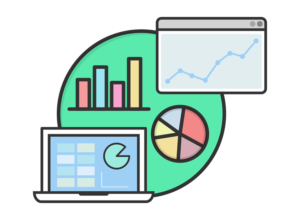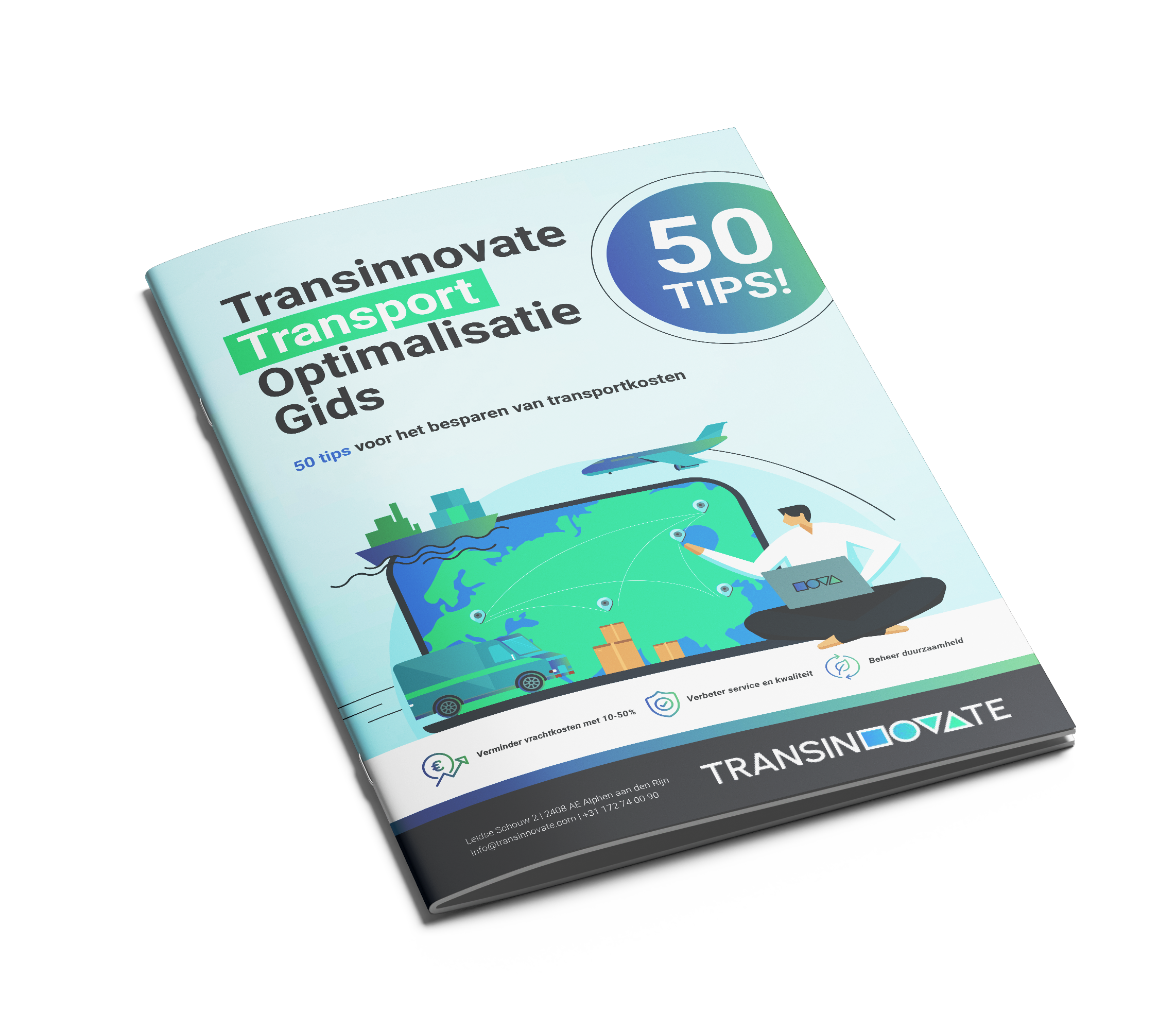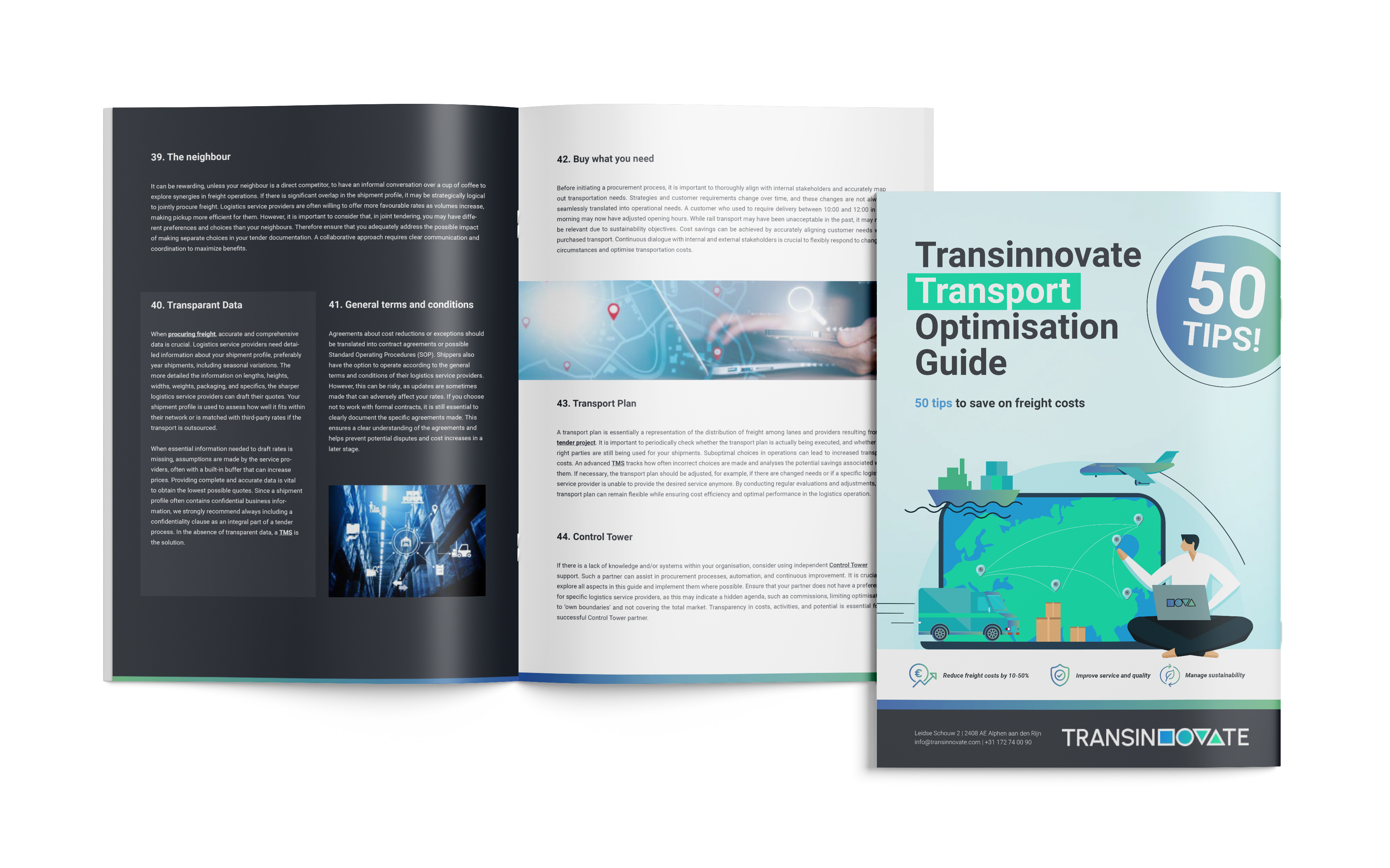Transinnovate biedt oplossingen aan voor een logistieke control tower, zowel de benodigde software system als ook de dienst. Omdat het een modewoord is, leggen we op deze pagina helder uit waarom een control tower handig is, wat er voor nodig is en hoe Transinnovate verladers hiermee kan helpen. Wilt u eens met ons sparren over wat een control tower u op kan leveren, neem dan gerust contact op.
Waarom een Control Tower?
Als jouw bedrijf fysieke goederen verhandeld of produceert, dan is transport essentieel voor je bedrijfsvoering. Het snijdt direct in op je commerciële marge en werkt direct door op je klanttevredenheid. Bij late levering, vertragingen of transportschade belt jouw klant immers jou, en niet je transporteur.
Vaak focussen bedrijven bij het zoeken naar verbetering op hun primaire proces, en is transport een onderbelicht aspect. “Het loopt, en we hebben nu andere projecten” is een veelgehoord antwoord. Een gebrek aan overzicht en actuele data is vaak de oorzaak dat dit niet daadkrachtig wordt opgepakt. Als er geen data is om op te sturen, dan is sturen vanzelf erg lastig.
De ervaring leert dat een control tower 10 tot 15% besparing kan opleveren op de transportkosten. Ook kan je kwaliteitsproblemen met transport ook meer gestructureerd en proactief kan oppakken, in plaats van een onderbuikgevoel. Ook kan actuele data uit je transportoperatie problemen elders in je proces signaleren. Een stijging van het aantal spoedzendingen kan bijvoorbeeld een teken zijn dat er problemen zijn bij productie. Er is voor bedrijven dus veel winst te behalen.

Wat is een Control Tower en wat is er voor nodig?
De term control tower is ontleend aan luchtverkeersleiding in een ‘control tower’ met centraal overzicht zo efficiënt (en veilig) mogelijk vliegverkeer afhandelt. Het draait hierbij om 1) het hebben van informatie en data, 2) de mogelijkheid om direct te kunnen sturen en 3) strakke processen en duidelijke verantwoordelijkheden.
Informatie: Het mag duidelijk zijn dat bij het aansturen van vliegtuigen het hebben van actuele en correcte informatie van levensbelang is. Hoewel er meestal geen letterlijk levensbelang is bij transport, is ook hier het hebben van actuele, volledige en correcte data een must, als je vervoerders goed wil kunnen aansturen. Veel verladers accepteren echter dat de informatie niet actueel is (maandrapporten en facturen van de vervoerder komen achteraf) en niet geïntegreerd. Het is vaak verspreid over een eigen ERP systeem (klantorders) en transportorders in de email of in de portal van (meerdere) vervoerders). Een goede control tower zorgt er dus in de eerste plaats voor dat er op één centrale plek actuele en complete data is over klantorders, transportorders, kosten en kwaliteit. Hier kan een Transport Management Systeem (TMS)uitkomst bieden voor verladers. Een TMS geeft veel betere data dan een (vaak rigide en beperkte) transportmodule in een ERP welke zich vaak alleen richt op het uitsturen van een transportorder. Dit kan detaildata zijn, maar ook maandrapportages waarbij informatie van meerdere vervoerders direct in één overzichtelijk dashboard of rapport staat.
Aansturen: Als de data er is, dan kan je gaan sturen. Daar moet dan wel de mogelijkheid voor zijn. Je moet knoppen hebben om aan te draaien. Hoe leg je vast wat goed gaat en wat niet? Wat kan je anders doen, als het niet loopt zoals je wil? Dat begint bij het slim inkopen van transport (transport tendering), waarbij ons advies is om de juiste mix van vervoerders (dus meer dan één) te kiezen die zorgt voor een kosteneffectieve maar ook robuuste operatie. Door vooraf goed te organiseren wordt goed managen een stuk makkelijker. Ook hier zorgt een goed TMS dat de mogelijkheden om te sturen op één en dezelfde plek aanwezig zijn als de data. Er is voor elke zending dan direct inzicht in de opties qua kosten en levertijd, er is inzicht in welke orders urgent actie behoeven en er is de mogelijkheid om kwaliteitsproblemen direct vast te leggen.
Heldere processen en verantwoordelijkheden: Met een TMS is de informatie beschikbaar en is er de mogelijkheid om te kunnen sturen. Daarmee komt vaak het lastigste deel in beeld, namelijk de kennis en discipline om ook daadwerkelijk controle te pakken. Goed gereedschap is het halve werk, maar de andere helft is discipline en vakmanschap. Luchtverkeersleiders krijgen ook niet voor niets een gedegen opleiding, en werken volgens strakke processen en duidelijke verantwoordelijkheden. Dit wordt vaak onderschat bij transport management. Voor zowel interne als externe stakeholders moet duidelijk zijn wat hun taken en verantwoordelijkheden zijn, en hoe er gewerkt dient te worden. Hierbij moet iemand de leiding pakken om hierop toe te zien. Analyse van key performance indicators moet leiden tot de juiste acties en het aansturen van de interne operatie en de logistieke dienstverleners.
Uitbesteden of zelf doen?
Met name vanwege het laatste aspect wordt een control tower nog wel eens uitbesteed. Dat heeft voordelen en nadelen. Voordeel is uiteraard dat verladers zelf niet hoeven te investeren in een TMS en dat de ingehuurde specialist er capaciteit voor vrijmaakt. Een nadeel is de onafhankelijkheid van de externe specialist, en de transparantie. 3PL en 4PL partijen hebben vaak afspraken met transporteurs waardoor ze niet noodzakelijkerwijs de beste vervoerders in de markt inzetten. Het kan ook zijn dat eigen auto’s vanwege de verkeerde redenen worden ingezet. Afhankelijk van het business model maken de dienstverleners niet per se de beste keuzes voor hun klanten (conflict of interest) en er is vaak geen volledige transparantie. De marge die een 3PL/4PL vraagt leidt ook kostenverhogend ten opzichte van zelf doen, en moet worden afgewogen tegen het zelf investeren in een TMS en tijd.
Zelf doen betekent zelf investeren in mensen en middelen, maar is altijd het meest transparant, leidt tot de meest directe grip op de transportoperatie, en geeft de meeste flexibiliteit om van vervoerder te wisselen als dat vanwege kwaliteit, kosten of marktonwikkelingen beter is.
Hoe kan Transinnovate verladers helpen
Wij kunnen verladers ondersteunen in alle stappen van het proces omtrent een control tower. Dat begint bij goed organiseren en slim inkopen, zodat er iets te kiezen en sturen valt. Daarnaast leveren wij modulaire en laagdrempelige TMS oplossingen waarmee transport management software nu ook bereikbaar is voor kleine bedrijven en MKBs. U heeft hiermee actuele en complete informatie overal inzichtelijk, en de mogelijkheid om direct in te grijpen. Wij kunnen helpen om processen en verantwoordelijkheden scherp neer te zetten, en uw personeel te trainen om dit effectief te kunnen managen. Tot slot kunnen wij u ook compleet ontzorgen waarbij wij de dienst aanbieden om uw Control Tower te beheren. Onze kennis, ervaring en onafhankelijke positie (geen afspraken met transporteurs en geen eigen transportmiddelen) zorgt ervoor dat wij transparant en effectief úw doelen kunnen helpen realiseren.
Zo helpen wij u op weg om een gezonde marge en tevreden klanten te houden (optimale transport kosten bij een goede kwaliteit).
Meer weten over hoe wij u kunnen helpen met het verlagen van uw transportkosten, neem dan gerust contact met ons op.




